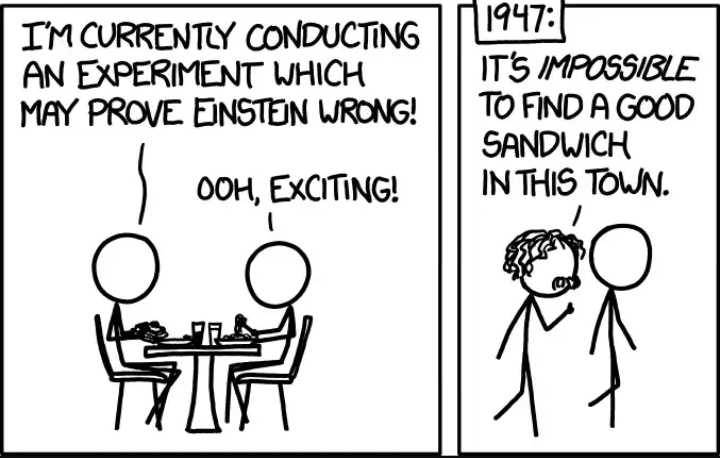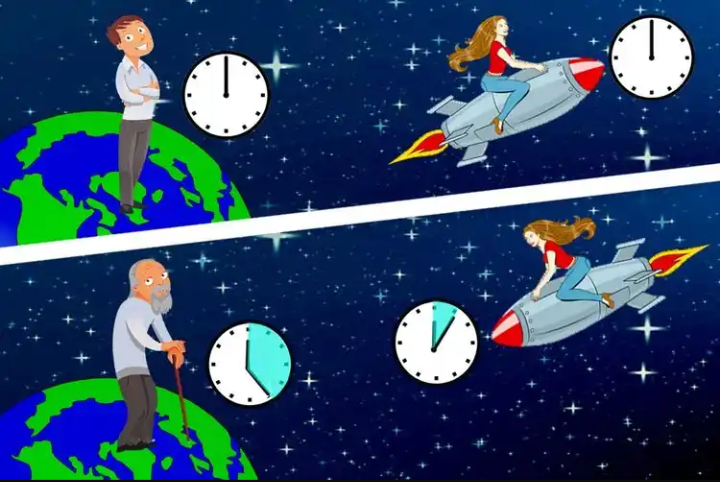Time-travel is popularly believed to be only possible in science fiction but, could this be true ?
I don't totally agree, in our previous article we showed the possibility of quantum particles experiencing time-travel and is due to them probably moving faster than the vacuum speed of light, somehow time-travel seems to exist in the quantum world but, what about the classical world ?
This question leads us to another branch of modern physics that was first conceived by Albert Einstein, which are the theories of classical relativity (special and general).
According to these theories, space and time are manifestations of the same entity - sometimes called spacetime, acting as separate entities. In fact, we don't exist in three dimensions (spatial) - length, width and height, we actually exist in four dimensions and time is the fourth dimension.
A consequence of this theory is that if we could move back and forth in space, then we could also move back and forth in time, the theories of Einstein's relativity thus predicts time-travel.
Fortunately for us we experience the time-travel (in the classical world) everyday, whether we choose to or not to, this time-travel is into the future and it happens in the form of time dilation.
Time dilation is predicted in special relativity - for motions in inertia frames ( non-accelerating) and general relativity - for motions in non-inertial frames (accelerating).
In the case of special relativity, imagine yourself moving with uniform velocity probably with your bicycle and your friend is stationary (at rest) at a point, each of you had your own clocks (you are with yours and your friend is with his) and these clocks were very sensitive to very small changes in time like the atomic clock, according to special relativity you that is moving would experience a slower flow of time than your friend that is at rest, that is if we assume you started your journey at, say 2:00 PM, after your journey your clock might read, say 2:01 PM and that of your friend, say 2:20 PM, notice that your friend seems far ahead of you in time. This means that if you go back to meet your friend, you would be seeing the future version of him, congratulations you have just travelled to the future. Weird right ?
As weird as it might seem, time dilation has been verified experimentally countless of times but the kind of time-travel we experience is not the very noticeable kind, on normal grounds we tend not to notice this time-travel effect because we move far lesser than the vacuum speed of light, because of this, the difference in time between you and your friend is so negligible that the time you experience when in motion is approximately equal to that of your friend at rest. It becomes very noticeable when you move at speeds closer to the vacuum speed of light, in fact, according to the mathematics of special relativity, if you move at 0.9c ( c = speed of light in vacuum) and 5 years elapses in your friends reference frame, then in your reference frame approximately 11 years would have elapsed for your friend, you would be seeing the 11 years older version of your friend when both of you meet or if your friend was 12 years old before you embarked on your journey, you would be seeing your friend when he is 23 years old after you embarked on the journey (you don't get older quickly because your time runs slower with respect to your friend's reference frame). This kind of time-travel leads to what is known as the twin paradox hypothetically - your twin can be older than you and vice-versa.
The theory of general relativity also predicts time-travel in many different ways which are discussed below
i. Gravitational time dilation, this kind of time dilation is experienced in a gravitational field. According to general relativity a point with higher gravitational influence would have time run slower than a point with lesser gravitational influence, what this also means is that one can time-travel to the future by jumping off a very high hill but it won't be noticeable because the velocities involved are far lesser than the vacuum speed of light.
If you want a noticeable time-travel, try jumping into a black hole and thank me later in the afterlife.
ii. Wormholes, closed time-like loops, Tipler cylinder, e.t.c , are the other means of time-traveling and they are special geometric structures of spacetime predicted by Einstein's field equations of general relativity, they predict time-travel both into the future and past but the conditions needed for the structures to exist doesn't exist and cannot be met in our real world even if we try to make it happen.
What this all means is that the kind of time-travel we could experience at classical scale is that into the future and due to time dilation but not the noticeable type like in days, months or years into the future, as a matter of fact, the kind we experience is within the millisecond range or lesser (not even up to a second).
It's only elementary/subatomic particles that can experience the noticeable type from a classical perspective and it's because the can move close/closer to the vacuum speed of light, which is in turn due to their very small masses.
If we at the macroscopic world wants to experience the noticeable kind of time-travel into the future, then we would need to design vehicles that move at speeds close/closer to the vacuum speed of light or jump into a gravitational field as strong as that of a black hole.
But let me warn you, don't be in a haste to jump into a black hole if you happen to encounter one very close by, unless you want to be spaghettified, thus leading to your premature death.
In our next article we would be discussing about time-travel into the past as it isn't treated here, have a thoughtful day and see you next time.
For further reading
Time travel is possible, but it’s a one-way ticket
Thank you all once again for stopping by to read my jargons and also thank you @juecoree, @discovery-it and the @OCD team for your valuable supports.
Lastly, please don't forget to do the needful
Upvote
Comment
Reblog
If you enjoyed my jargons.







~2.jpeg)
I have always wondered if time-lapse affects astronauts by the time they come back to the earth after spending considerable time in space. Do they grow older or younger than they are supposed to be or there is no difference? I know it's not likely that the rocket travels at a speed close to that of light.
I suppose you mean astronauts, it actually depends on what they are doing in outer space. If they are not moving at all or moving around Earth at speeds lesser than that our planet (average orbital speed of earth is about 1670 km/hr), then they would grow older from our (we on Earth) perspective. But if they move at speeds greater than that of earth then we observe them to grow younger and this is generally due to "relative velocity time dilation". There's actually a space station (located outer space) called ISS (international space station) - it's main purpose is to carry out experimental researches not possible in our planet, it moves at a speed of about 27,600 km/hr (it moves relatively faster than Earth) so astronauts there if they get back to Earth, would look younger than they are supposed to be. But for the fact that the speed is still far lesser than the vacuum speed of light, we won't notice it.
Interesting
Dear @clinton19, I'm South Korean, so it's hard to understand your profound English sentences.
I remember Einstein never talked about time travel.
I remember the post-Einstein scholars were the first to claim that human time travel was possible if we exceeded the speed of light.
What is the basis for claiming that if we exceed the speed of light, we can overcome the barriers of time and space?
Does light create the space-time in which we exist?
I don't know for sure why he never talked about time-travel, it could be that he wasn't aware his theories predicted it or he was aware and didn't believe it existed, just like he never believed black holes existed though he was aware general relativity predicted it.
The principle's of special relativity is the basis. Light doesn't create space-time, the thing is that casualty is broken,read this article and for better clarification study the lightcone diagram in Minkowski spacetime/the theory of special relativity itself. Note that his theories had undergone thorough examination and advances during the post-Einstein era.
@goldgrifin007 and @clinton19, never say never.🤓
https://en.wikipedia.org/wiki/Kurt_G%C3%B6del
Ooh, so he was aware and didn't believe. Nice one 👍👍 @holovision.
Dear @holovision, Thank you for your help!
It is clear that the current theory of relativity was created by adding new theories to Einstein's theory by younger scientists.
Thank you!
You're welcome
Your content has been voted as a part of Encouragement program. Keep up the good work!
Use Ecency daily to boost your growth on platform!
Support Ecency
Vote for Proposal
Delegate HP and earn more
Thanks for the support.
Thanks for your contribution to the STEMsocial community. Feel free to join us on discord to get to know the rest of us!
Please consider supporting our funding proposal, approving our witness (@stem.witness) or delegating to the @stemsocial account (for some ROI).
Please consider using the STEMsocial app app and including @stemsocial as a beneficiary to get a stronger support.
Congratulations @clinton19! You have completed the following achievement on the Hive blockchain and have been rewarded with new badge(s) :
Your next target is to reach 4000 upvotes.
You can view your badges on your board and compare yourself to others in the Ranking
If you no longer want to receive notifications, reply to this comment with the word
STOP